
I just met my 5-year-old niece recently at a family gathering, and she loves pretend play. She designed different scenarios for me to participate in together with her as different characters in stories and act out the plot she wanted to experience. While playing with her, I recalled the fact that I also loved and enjoyed pretend plays when I was little and had great times with my friends while pretending to be fictional characters and dreaming about being in fictional stories. It made me wonder why children would enjoy this and if pretend plays would enhance their brain development in any way.
An experiment conducted by Alison Gopnik, Ph.D., a developmental psychologist at the University of California, Berkeley, and her colleagues, investigates the link between pretend play and counterfactual causal reasoning in 3- and 4-year-olds and provided me with insights into this matter (Gopnik et al 2012). Counterfactual reasoning is a psychological concept that involves the human tendency to create possible alternatives to events or scenarios that have already happened in your life or could possibly happen in the future.
In this experiment, 3- and 4-year-olds were taught a novel causal relationship and then were encouraged to engage in a pretend game to see if they would maintain and act on this relationship in the context of an imaginary world (Gopnik et al 2012). The causal relationship involved a toy, the ‘Birthday machine,’ which plays ‘Happy Birthday’ when an object called a zando is placed on top, but which does not activate with a non-zando object (Gopnik et al 2012).
During the study, Dr. Gopnik and her colleagues told children that it was a stuffed toy named Monkey’s birthday, and that the experimenter and the child would use the ‘Birthday machine’ to sing to Monkey as a surprise for his birthday (Gopnik et al 2012). The experimenter taught the child the causal relationship and then asked him/her a series of counterfactual questions about the machine (Gopnik et al 2012).
Then, a staff entered the room and removed the machine, the zando and the non-zando object (Gopnik et al 2012). Instead, they were replaced with a box and two blocks and the staff explained that they could still surprise Monkey if they pretended that the replaced objects and box were the machine, the zando, and the non-zando (Gopnik et al 2012). The experimenter first asked the child what he or she wanted to pretend (Gopnik et al 2012). Then the experimenter prompted the child to try each block on the machine and asked him/her what they were pretending was the consequence of this action, to see if the child would uphold the real-world causal relationship she/he had learned in the context of the pretend game (Gopnik et al 2012).
The results of the experiment show that most of the children (71%) spontaneously elaborated the pretend scenario beyond the experimenter’s questions and nearly half (44%) engaged in extended pretence, indicating that the children were indeed pretending (Gopnik et al 2012). There was no difference in the counterfactual performance of children who demonstrated extended or elaborated pretence or simpler pretence (Gopnik et al 2012). Overall, Dr. Gopnik concluded that children were able to respond correctly to counterfactual questions about a novel real-world causal relationship and flexibly reassign the causal roles of objects within the pretense; moreover, children’s performance on the counterfactual questions correlated with their pretense performance: Children who are better at pretend plays tend to have better counterfactual reasoning abilities.
To apply the results to the behavior I’ve observed on my niece, I reckon that pretend play can actually help her cope with events that might occur in the future and allows her to do “mock trials” over and over again to pretend and get different results out of these plays. Through these pretend plays, her counterfactual reasoning skills are practiced and it certainly is a significant part of her brain development process that would enable her to combat these situations in real life when she gets older. Isn’t pretending to be adults and learning how to properly be like them an inseparable part of us growing up?
Reference:
Buchsbaum D, Bridgers S, Skolnick Weisberg D, Gopnik A. The power of possibility: causal learning, counterfactual reasoning, and pretend play. Philosophical transactions of the Royal Society of London. Series B, Biological sciences. 2012;367(1599):2202–2212.
Hi Charlotte, this was such an interesting read. It was very relatable as I too have played pretend as a child. Even as adults, I think we all still “pretend” in the form of preparation. We will either perform interactive presentations out loud to ourselves or practice for an interview. It was interesting to learn how these moments can improve our counterfactual reasoning skills!
I definitely believe that children has more imaginations than adults. The word pretence in really intriguing to use since pretence insinuates that children are aware about the fact yet they pretend they knew it. In the Monkey’s birthday, the utilization of counterfactual questions signified that children have a completed mindset in how to imagine an event. Overall, the blog is really interesting and insightful. It is amazing how you could extract ideas from daily life!